中国墓葬文化【英语】
中国传统丧葬文化英语作文
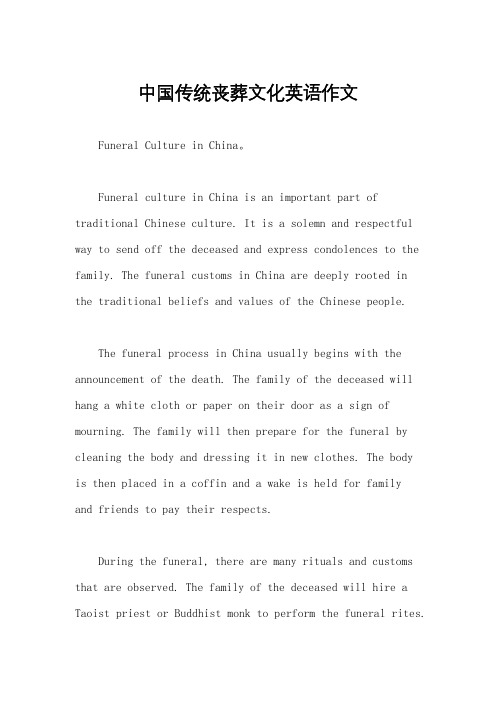
中国传统丧葬文化英语作文Funeral Culture in China。
Funeral culture in China is an important part of traditional Chinese culture. It is a solemn and respectful way to send off the deceased and express condolences to the family. The funeral customs in China are deeply rooted in the traditional beliefs and values of the Chinese people.The funeral process in China usually begins with the announcement of the death. The family of the deceased will hang a white cloth or paper on their door as a sign of mourning. The family will then prepare for the funeral by cleaning the body and dressing it in new clothes. The bodyis then placed in a coffin and a wake is held for familyand friends to pay their respects.During the funeral, there are many rituals and customs that are observed. The family of the deceased will hire a Taoist priest or Buddhist monk to perform the funeral rites.The priest or monk will recite scriptures and perform rituals to guide the soul of the deceased to the afterlife. The family will also burn incense and paper money as offerings to the deceased.In addition to the funeral rites, there are also many taboos and superstitions that are observed during the funeral. For example, the family of the deceased should not wear bright or colorful clothing as a sign of respect. They should also avoid laughing or speaking loudly during the funeral. It is also considered bad luck to sweep the floor or take a bath during the funeral period.After the funeral, the family of the deceased will hold a memorial service to honor the deceased. This is an opportunity for family and friends to share memories and stories about the deceased. The family will also continue to burn incense and paper money as offerings to the deceased.Overall, funeral culture in China is a deeply rooted tradition that is still observed today. It is a way for theChinese people to honor and respect their ancestors and loved ones. While some of the customs and taboos may seem strange to outsiders, they are an important part of Chinese culture and should be respected.。
介绍乾陵的英语作文
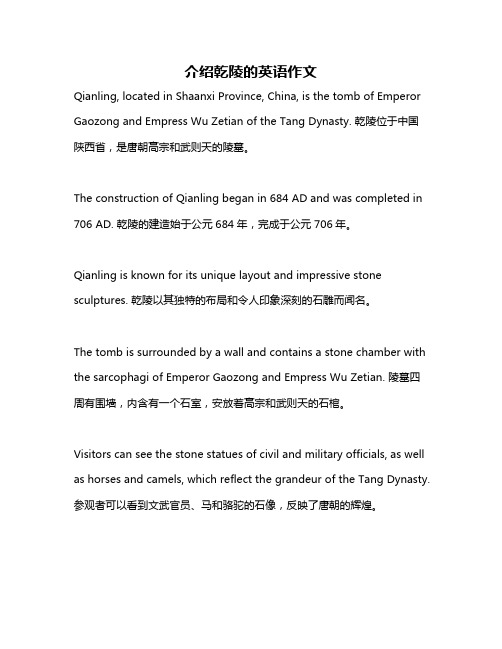
介绍乾陵的英语作文Qianling, located in Shaanxi Province, China, is the tomb of Emperor Gaozong and Empress Wu Zetian of the Tang Dynasty. 乾陵位于中国陕西省,是唐朝高宗和武则天的陵墓。
The construction of Qianling began in 684 AD and was completed in 706 AD. 乾陵的建造始于公元684年,完成于公元706年。
Qianling is known for its unique layout and impressive stone sculptures. 乾陵以其独特的布局和令人印象深刻的石雕而闻名。
The tomb is surrounded by a wall and contains a stone chamber with the sarcophagi of Emperor Gaozong and Empress Wu Zetian. 陵墓四周有围墙,内含有一个石室,安放着高宗和武则天的石棺。
Visitors can see the stone statues of civil and military officials, as well as horses and camels, which reflect the grandeur of the Tang Dynasty. 参观者可以看到文武官员、马和骆驼的石像,反映了唐朝的辉煌。
The tomb of Qianling is also famous for its mural paintings, which depict various scenes from the daily life of the Tang Dynasty. 乾陵的墓室壁画也以描绘唐代日常生活的各种场景而闻名。
中国的世界文化遗产-英文版
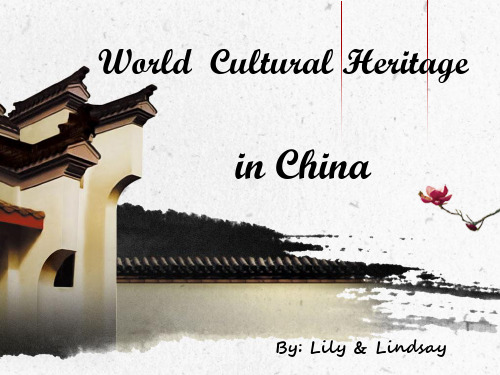
in China
By: Lily & Lindsay
Contents
自行Cu添lt加ur标a题l Heritage
2 自行添加标题
historical
文物
பைடு நூலகம்relic
自行a添r加ch标it题ectural Complex
自行添加标建题筑群
Monument
Temple of Confucius The Temple of Heaven
The Mogao Grottoes
Mausoleum of the First Qin Emperor
The Potala Palace Lhasa
The Ancient City-Li jiang
West Lake
sentence
It is listed as World Cultural Heritage by UNESCO in 年份
UNESCO: United Nations Educational, Scientific and Cultural Organization 联合国教科文组织
谢谢大家!
遗址
Architectural Complex
Mausoleum of the First Qin Emperor The Potala Palace Lhasa The Ancient City-Li jiang West Lake
The palace Museum The Great Wall
The palace Museum
The Great Wall
Temple of Confucius, Cemetery of Confucius and Kong Family Mansion in Qufu
高考英语素材积累之文化遗产保护知识清单-2025届高三英语上学期一轮复习专项
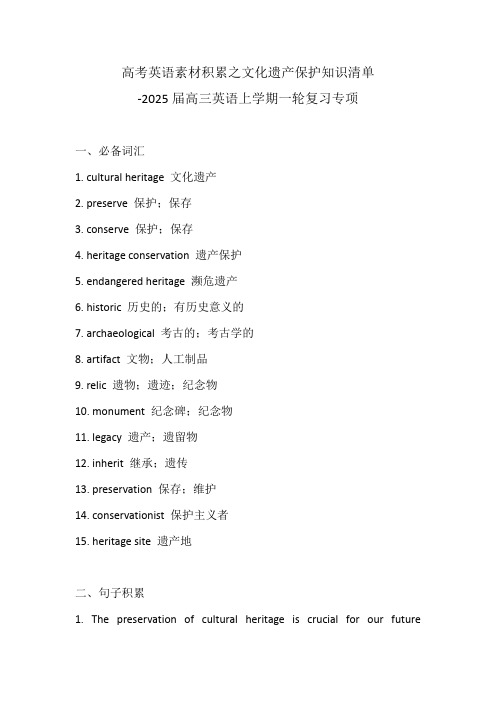
高考英语素材积累之文化遗产保护知识清单-2025届高三英语上学期一轮复习专项一、必备词汇1. cultural heritage 文化遗产2. preserve 保护;保存3. conserve 保护;保存4. heritage conservation 遗产保护5. endangered heritage 濒危遗产6. historic 历史的;有历史意义的7. archaeological 考古的;考古学的8. artifact 文物;人工制品9. relic 遗物;遗迹;纪念物10. monument 纪念碑;纪念物11. legacy 遗产;遗留物12. inherit 继承;遗传13. preservation 保存;维护14. conservationist 保护主义者15. heritage site 遗产地二、句子积累1. The preservation of cultural heritage is crucial for our futuregenerations. 文化遗产的保护对我们的后代至关重要。
2. Cultural heritage is a precious treasure that needs to be protected and cherished. 文化遗产是需要被保护和珍视的珍贵宝藏。
3. We must take active steps to safeguard our cultural heritage from being lost or damaged. 我们必须采取积极措施来保护我们的文化遗产不被丢失或损坏。
4. The rich cultural heritage of our country is a source of pride and inspiration. 我们国家丰富的文化遗产是自豪和灵感的源泉。
5. Protecting cultural heritage is not only our responsibility, but also our obligation. 保护文化遗产不仅是我们的责任,也是我们的义务。
古代中国文化英语版
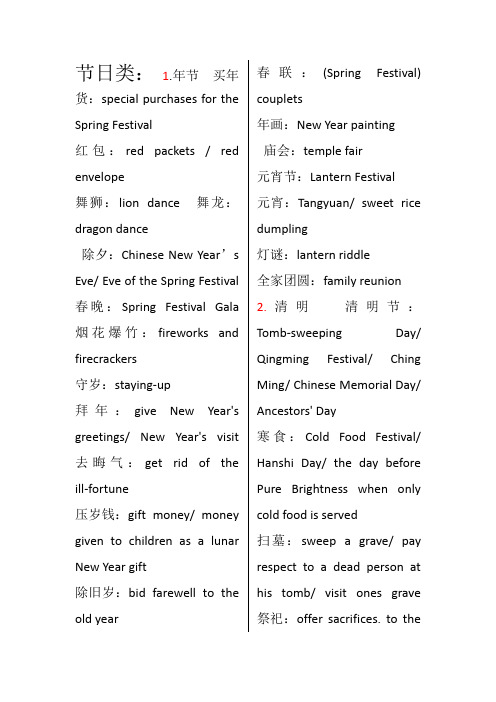
节日类:1.年节买年货:special purchases for the Spring Festival红包:red packets / red envelope舞狮:lion dance 舞龙:dragon dance除夕:Chinese New Year’s Eve/ Eve of the Spring Festival 春晚:Spring Festival Gala 烟花爆竹:fireworks and firecrackers守岁:staying-up拜年:give New Year's greetings/ New Year's visit 去晦气:get rid of the ill-fortune压岁钱:gift money/ money given to children as a lunar New Year gift除旧岁:bid farewell to the old year 春联:(Spring Festival) couplets年画:New Year painting庙会:temple fair元宵节:Lantern Festival元宵:Tangyuan/ sweet rice dumpling灯谜:lantern riddle全家团圆:family reunion 2.清明清明节:Tomb-sweeping Day/ Qingming Festival/ Ching Ming/ Chinese Memorial Day/ Ancestors' Day寒食:Cold Food Festival/ Hanshi Day/ the day before Pure Brightness when only cold food is served扫墓:sweep a grave/ pay respect to a dead person at his tomb/ visit ones grave 祭祀:offer sacrifices. to thegods or the spirits of the dead 纸钱:spiritual money先人:ancestor/ forefather 踏青:have an outing in spring 青团:Qingtuan: green dumplings made of glutinous rice and barley grass出行高峰:travel peak3.端午端午节:Dragon Boat Festival粽子:zongzi, pyramid-shaped dumplings made of glutinous rice, stuffed with different fillings and wrapped in bamboo or reed leaves雄黄酒:realgar wine赛龙舟:dragon boat race 佩香囊:wear a sachet. They first sew little bags with colorful silk cloth, then fill the bags with perfumes or herbal medicines, and finally string them with silk thread.系五彩线:tie five colored rings驱五毒:drive away the five poisonous creatures/ drive away poisonous pests, including scorpions, vipers, centipedes, house lizards andtoads.游百病:prevent disease by having fun/ Entertainment for all is said to ward off disease. 农历五月初五:the 5th day of the 5th month of the traditional Chinese calendar 楚国:the antient state of Chu 投江自尽:drown oneself 纪念:commemorate菖蒲:calamus艾草:wormwood驱邪避疫:prevent disease or evil4.中秋及其他中秋节:Mid-Autumn Festival月饼:moon cake赏月:watch and admire the moon皎洁:(of moonlight) bright and clean玉兔:Jade Rabbit 嫦娥:Chang’e中元节:Ghost Festival七夕:Magpie Festival重阳节:Double Ninth Festival 5.节气及其他节气:seasonal division points立春:spring begins惊鸷:insects awaken雨水:the rains春分:vernal equinox谷雨:grain rain立夏:summer begins小满:lesser fullness芒种:grain in ear 夏至:summer solstice 小暑:sight heat大暑:great heat立秋:autumn begins 处暑:end of heat白露:white dew秋分:autumn equinox 寒露:cold dews霜降:hoar-frost falls 立冬:winter begins小雪:light snow大雪:heavy snow冬至:winter solstice 小寒:slight coldness 大寒:great coldness 地支:Earthly Branch 天干:Heavenly Stem 生肖:Chinese zodiac 阴历:solar calendar 闰年:leap year文学思想类:儒家文化:Confucian culture儒家学派:Confucianism 孔子:Confucius孟子:Mencius四书:the Four Books五经:the Five Classics《诗经》:The Book of Songs 《史记》:Historical Records/ Records of the Grand Historian《西游记》:The Journey to the West《水浒传》:Water Margin 《红楼梦》:A Dream in Red Mansions工艺器物类:中国古代四大发明:the four great inventions of ancient China 火药:gunpowder造纸术:paper-making印刷术:printing 指南针:compass瓷器:porcelain/ china陶器:pottery/ earthenware 漆器:lacquer玉石:jade唐三彩:tricolor glazed pottery of the Tang Dynasty 景泰蓝:cloisonnéenamel 蜡染:batik旗袍:cheongsam唐装:Tang Suit中国结:Chinese knot亭/阁:pavilion/ attic刺绣:embroidery虎头鞋:tiger-head-shoes 宫灯:palace lantern木/石/竹刻:wood/ stone/ bamboo carving木刻画:wood engraving泥人儿:clay figure剪纸:paper cut皮影:shadow puppet双面绣:two-sided embroidery檀香扇:sandalwood fan微雕:miniature engraving 象牙雕刻:ivory carving书法绘画类:甲骨文:inscriptions on bones or tortoise shells of the Shang Dynasty象形文字:pictograms/ pictographic characters偏旁:radical繁体字:traditional Chinese characters书法:calligraphy楷书:regular script麦秸画:straw patchwork漆画:lacquer painting中国画:Chinese painting水墨画:Chinese brush drawing / ink and wash painting 文人画:literati painting仕女画:traditional Chinese painting of beautiful women 吴派山水:Wu school landscape金碧山水:gold-and—green landscape草虫画:grasses and insects painting泼墨山水:splashed ink landscape气韵:spirit and charm/ tone 侧锋:brush-side technique 笔法:brush style写意画:free sketch/ freehand brushwork文房四宝(笔墨纸砚):the four treasure of the study, brush, ink stick, paper, and ink stone印/玺:seal/ stamp篆刻:seal cutting拓碑:making rubbings from inscriptions/ pictures on stone tablets拓片:rubbing历史类:春秋the Spring and Autumn Period 战国:Warring States丝绸之路:Silk Road鸦片战争:the Opium War 辛亥革命:the Revolution of 1911 大跃进:Great Leap Forward (Movement)四人帮:Gang of Four文化大革命:Cultural Revolution红卫兵:Red Guard太监:eunuch缠足:foot-binding生活习俗类:民俗:folkways四合院:Siheyuan/ Quadrangle 风水:Fengshui/ Geomantic Omen红白喜事:weddings and funerals集体舞:group dance小吃摊:snack bar/ snack stand茶馆:teahouse/ teabar铁饭碗:iron bowl结婚证:marriage certificate 剩女:leftover woman古装片:costume drama武打片:Chinese swordplay movie戏曲:traditional opera杂耍:vaudeville京剧:Beijing Opera/Peking Opera京剧脸谱:types of facial makeup in Beijing opera生:male characters末:middle-aged malecharacters净:”painted face”characters 旦:female characters丑:clown秦腔:Qin Opera相声:cross-talk/ comic dialogue电视小品:TV sketch/ TV skit 太极拳:Tai Chi/ shadowboxing门当户对:perfect match/ exact match门神:door gods对联:poetic couplet龙图腾:the dragon totem 中医:traditional Chinese medicine针灸:acupuncture国家中医药管理局:State Administration of TCM Pharmacology社会政治类:一国两制:one country, two systerms中国特色社会主义:Chinese-characterSocialist/Socialist with Chinese characteristics大中型国有企业:large and medium-sized State-owned enterprises合资企业:joint venture物质精神文明建设:construction of material and spiritual civilization下岗:lay off/ laid off地理名胜类:黄土高原:Loess Plateau长江中下游地区:The Mid-low Reaches of Yangtze River天坛:Altar of Heaven in Beijing故宫博物院:The PalaceMuseum御花园:imperial garden莫高窟:Mogao Caves西湖:West Lake兵马俑:cotta Warriors/ Terracotta Army美食类:馄饨:wonton 锅贴:guotie (fried jiaozi)花卷:steamed twisted rolls 套餐:set meal盒饭:box lunch/ Chinese take-away米豆腐:rice tofu魔芋豆腐:konjak tofu米粉:rice noodles冰糖葫芦:a stick of sugar-coated haws (or apples,etc.)火锅:chafing dish/ hot pot 八宝饭:eight-treasure rice pudding粉丝:glass noodles 豆腐脑:jellied bean curd酱油:soy sauce臭豆腐:stinky tofu大闸蟹:Chinese mitten crab 春卷:spring roll年糕:rice cake本帮菜:local cuisine舌尖上的中国:A Bite of China宗教及其他:禅宗:Zen Buddhism道教:Taoism神道教:Shiutoism佛教:Buddhism和尚:bonze财神:the God of Wealth土地神:Local God of the Land 龙王:Dragon King寿:longevity福:good fortune和:harmony。
高中英语 Unit 5 Meeting your ancestors 中国的世界文化遗产素材 新人教

高中英语 Unit 5 Meeting your ancestors 中国的世界文化遗产素材新人教版选修8中国的世界文化遗产第二次世界大战结束之后,现代化进程迅猛如潮.给人类的居住环境和文化遗存带来了巨大的压力和破坏。
为了使物质文明的进步与环境保护相协调.为了全人类的可持续发展,联合国教科文组织成员国于1972年倡导并缔结了《保护世界文化和自然遗产公约》。
公约主要考虑到部分文化或自然遗产具有突出的重要性.因而需要作为全人类世界遗产的一部分加以保护;考虑到鉴于威胁这类遗产的新危险的规模和严重性,整个国际社会有责任通过提供集体性援助来参与保护具有突出的普遍价值的文化和自然遗产。
缔约国内的文化和自然遗产,由缔约国申报,经世界遗产中心组织权威专家考察、评估.世界遗产委员会主席团会议初步审议,最后经公约缔约国大会投票通过并列入《世界遗产名录》。
遗产种类有文化遗产、自然遗产和文化、自然双重遗产。
列入《世界遗产名录》的文化遗产.称为世界文化遗产。
中国的世界文化遗产明清故宫:文化遗产,1987年列入,北京市颐和园:文化遗产,1998年列入,北京市天坛:文化遗产,1998年列入,北京市长城:文化遗产,1987年列入,北京市周口店“北京人“遗址:文化遗产,1987年列入,北京市承德避暑山庄及周围寺庙:文化遗产,1994年列入,河北省平遥古城:文化遗产,1997年列入,山西省曲阜孔庙孔林孔府:文化遗产,1994年列入,山东省敦煌莫高窟:文化遗产,1987年列入,甘肃省大足石刻:文化遗产,1999年列入,重庆市秦始皇陵:文化遗产,1987年列入,陕西省苏州古曲园林:文化遗产,1997年列入,江苏省武当山古建筑群:文化遗产,1994年列入,湖北省拉萨布达拉宫:文化遗产,1994年列入,西藏自治区丽江古城:文化遗产,1997年列入,云南省泰山:自然与文化遗产,1987年列入,山东省黄山:自然与文化遗产,1990年列入,安徽省峨眉山-乐山大佛风景名胜区:自然与文化遗产,1996年列入,四川省九寨沟风景名胜区:自然遗产,1992年列入,四川省黄龙风景名胜区:自然遗产,1992年列入,四川省武陵源风景名胜区:自然遗产,1992年列入,湖南省庐山风景名胜区:世界文化景观,1995年列入,江西省武夷山风景名胜区:自然与文化遗产,1999年列入,福建省龙门石窟:文化遗产,2000年列入,河南省青城山-都江堰:文化遗产,2000年列入,四川省皖南古村落(西递、宏村):文化遗产, 2000年列入,安徽省明清皇家陵寝:文化遗产,(湖北明显陵、河北清东陵、河北清西陵)2000年列入,(北京十三陵、南京明孝陵)2003年列入云冈石窟: 文化遗产, 2001年列入,山西省高句丽王城、王陵及贵族墓葬:文化遗产, 2004年列入,吉林省澳门历史城区: 文化遗产,2005年列入, 澳门特别行政区三江并流: 自然遗产,2003年列入,云南省四川大熊猫栖息地: 自然遗产,2006年列入,四川省安阳殷墟:历史文化遗产,2006年7月13日列入,河南省。
中国丧葬文化英语作文
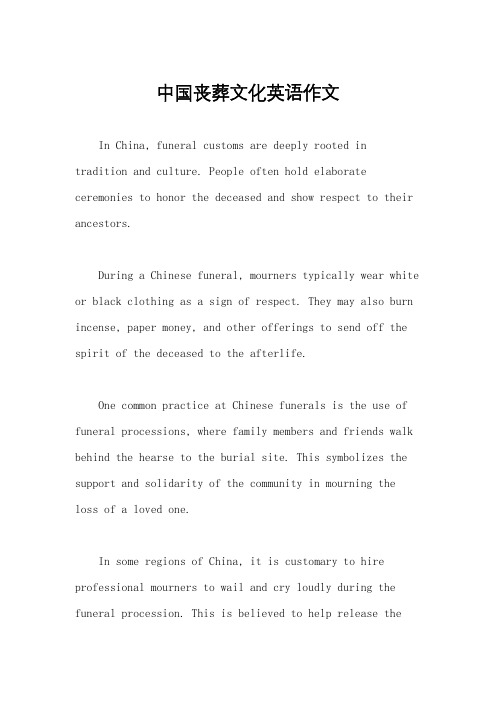
中国丧葬文化英语作文In China, funeral customs are deeply rooted intradition and culture. People often hold elaborate ceremonies to honor the deceased and show respect to their ancestors.During a Chinese funeral, mourners typically wear white or black clothing as a sign of respect. They may also burn incense, paper money, and other offerings to send off the spirit of the deceased to the afterlife.One common practice at Chinese funerals is the use of funeral processions, where family members and friends walk behind the hearse to the burial site. This symbolizes the support and solidarity of the community in mourning the loss of a loved one.In some regions of China, it is customary to hire professional mourners to wail and cry loudly during the funeral procession. This is believed to help release thesoul of the deceased and bring peace to their spirit.After the funeral, a feast is often held to celebrate the life of the deceased and to bring together family and friends in remembrance. This gathering is seen as a way to comfort each other and share memories of the departed.In Chinese culture, ancestor worship is an important aspect of funeral customs. Families may continue to honor their ancestors through rituals and ceremonies, ensuring that their spirits are at peace and watching over their descendants.Overall, Chinese funeral customs reflect the belief in the importance of honoring the deceased and maintaining a connection with the past. These traditions are a way to show respect, remember loved ones, and find solace in the face of loss.。
七年级英语Part 3(Cultural link 文化链接)人教四年制版知识精讲

七年级英语Part 3(Cultural link 文化)人教四年制版【同步教育信息】一. 本周教学内容Part 3(Cultural link 文化)二. 本周重点及难点(一)重点词语及表达1. project 方案,计划,规划= plan[,e]Let’s make a project / plan about our trip . 让我们制定一个旅游计划。
2. wonder 奇观,奇事,奇才(名)[Λ]wonderful 精彩的(形)The Great Wall is one of the greatest wonders of the world .长城是世界上最伟大的奇观之一。
3. the Museum of Terra Cotta Warriors and Horses 陶兵陶马博物馆[’ter][’k t][’w ri z]terra cotta 赤土赤陶,赤褐色warrior 勇士4. province 省[][ i ]in Shanxi Province 在某某省5. bury 埋葬,葬buried(过去式)[e][ i ]The children buried the dead bird in the garden .孩子们把死鸟埋在花园里。
6. grave 坟墓[ei ]7. emperor 皇帝[’emp r]Qin Shihuang was the first Chinese Emperor . 秦始皇是中国的第一个皇帝。
8. mountain 山,山峦[au][ i ]the Yellow Mountains 某某Huangshan is called the Yellow Mountains in English .9. north 北,北方south 南,南方west 西,西方east 东,东方[:] [au][e ][i : ]in north China = in the north of China 在中国的北方in south Anhui Province = in the south of Anhui Province 在某某省南部northwest 西北 a northwest wind 西北风northeast 东北southwest 西南southeast 东南10. be famous for 因…而著称[ei] []Huangshan is famous for its beautiful mountains .某某以其秀美的山峦而著称。
中国文化的遗物英语作文
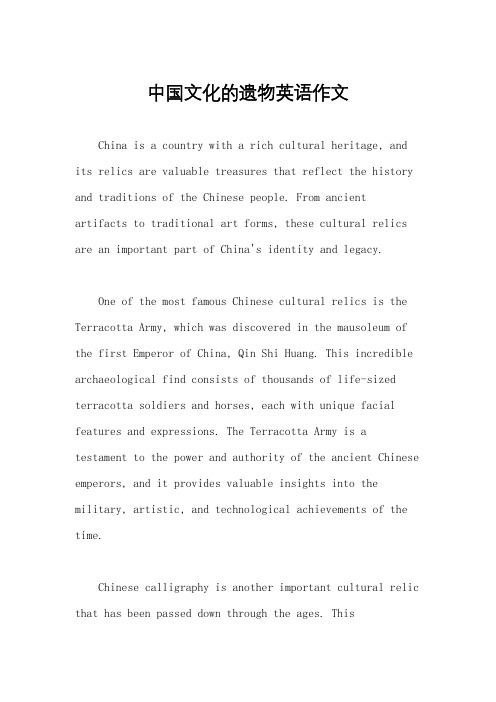
中国文化的遗物英语作文China is a country with a rich cultural heritage, and its relics are valuable treasures that reflect the history and traditions of the Chinese people. From ancientartifacts to traditional art forms, these cultural relics are an important part of China's identity and legacy.One of the most famous Chinese cultural relics is the Terracotta Army, which was discovered in the mausoleum of the first Emperor of China, Qin Shi Huang. This incredible archaeological find consists of thousands of life-sized terracotta soldiers and horses, each with unique facial features and expressions. The Terracotta Army is a testament to the power and authority of the ancient Chinese emperors, and it provides valuable insights into the military, artistic, and technological achievements of the time.Chinese calligraphy is another important cultural relic that has been passed down through the ages. Thistraditional art form uses brush and ink to create beautiful and expressive characters, and it is considered a highly respected and revered practice in Chinese culture. Calligraphy is not only a form of writing, but also a means of artistic expression, and it is often used in poetry, painting, and other forms of traditional Chinese art.The Great Wall of China is perhaps the most iconic cultural relic in China, and it is a symbol of thecountry's ancient civilization and enduring spirit. This massive fortification stretches for thousands of miles across northern China, and it was originally built toprotect the Chinese empire from invasions by nomadic tribes. The Great Wall is a testament to the ingenuity and determination of the Chinese people, and it continues to be a source of national pride and inspiration.Chinese traditional medicine is an integral part of the country's cultural heritage, and it has been practiced for thousands of years. This holistic approach to health and wellness includes techniques such as acupuncture, herbal medicine, and qigong, and it is based on the principles ofbalance and harmony within the body. Chinese traditional medicine reflects the deep connection between the Chinese people and the natural world, and it continues to be an important part of modern healthcare practices in China and around the world.In addition to these well-known cultural relics, Chinais also home to a wide variety of traditional festivals, performing arts, and culinary traditions that have been passed down through the generations. These culturalpractices and customs are an integral part of Chinese society, and they continue to play a vital role in shaping the country's identity and values.In conclusion, China's cultural relics are a testamentto the country's rich history, traditions, and achievements. From ancient artifacts to traditional art forms, theserelics are valuable treasures that provide valuableinsights into the cultural heritage of the Chinese people. They are a source of national pride and inspiration, and they continue to be an important part of China's identity and legacy.。
中国丧葬文化英语作文高中
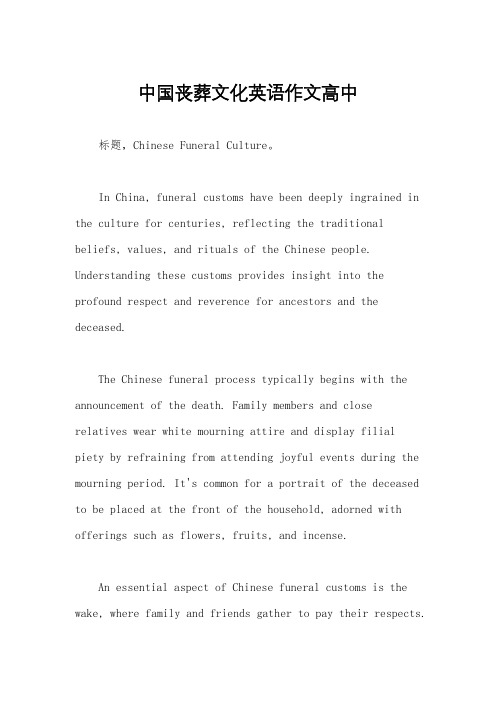
中国丧葬文化英语作文高中标题,Chinese Funeral Culture。
In China, funeral customs have been deeply ingrained in the culture for centuries, reflecting the traditional beliefs, values, and rituals of the Chinese people. Understanding these customs provides insight into the profound respect and reverence for ancestors and the deceased.The Chinese funeral process typically begins with the announcement of the death. Family members and closerelatives wear white mourning attire and display filialpiety by refraining from attending joyful events during the mourning period. It's common for a portrait of the deceased to be placed at the front of the household, adorned with offerings such as flowers, fruits, and incense.An essential aspect of Chinese funeral customs is the wake, where family and friends gather to pay their respects.During the wake, mourners offer condolences, share memories of the deceased, and provide comfort to the grieving family. The atmosphere is solemn, with rituals such as bowingbefore the deceased and burning paper money for the deceased's journey to the afterlife.After the wake, preparations for the funeral ceremony begin. Traditional Chinese funerals often incorporateTaoist or Buddhist rituals, depending on the family's religious beliefs. The ceremony typically includes chanting by monks or priests, recitation of scriptures, and the burning of incense to purify the surroundings and guide the soul of the deceased to the afterlife.One significant aspect of Chinese funeral culture is ancestor veneration. The Chinese believe in the importanceof honoring their ancestors and ensuring their well-beingin the afterlife. Ancestor worship involves offering prayers, incense, and food at ancestral altars duringspecial occasions such as Qingming Festival or thedeceased's death anniversary.The burial process holds deep symbolism in Chinese culture. The choice of burial site and the orientation of the grave are carefully considered to ensure harmony between the deceased and the surrounding environment. Traditional Chinese gravesites often feature elaborate tombstones, ancestral tablets, and offerings to provide comfort and sustenance to the deceased in the afterlife.In recent years, there has been a gradual shift towards modernization in Chinese funeral customs. Some families opt for cremation instead of traditional burial, influenced by factors such as urbanization, environmental concerns, and changing attitudes towards death and afterlife beliefs.Despite these changes, the core values of filial piety, respect for ancestors, and honoring the deceased remain central to Chinese funeral culture. It serves as a reminder of the importance of family, tradition, and spirituality in Chinese society.In conclusion, Chinese funeral culture is a rich tapestry of traditions, rituals, and beliefs that reflectthe profound respect and reverence for the deceased and ancestors. It is an integral part of Chinese society, embodying the values of filial piety, harmony, andspiritual connection that have endured for centuries. As China continues to modernize, the essence of its funeral customs serves as a timeless reminder of the importance of honoring the past while embracing the future.。
中国葬礼英文Funeral rituals电子教案
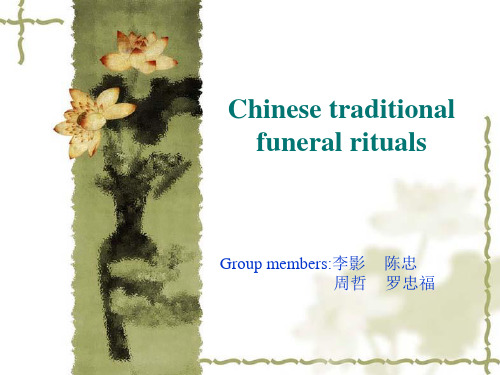
Setting up memorial tablet(立牌位)
Set up memorial tablet for the dead
Sweeping tomb (扫墓)
❖ pulling out weeds around the headstone, replacing dead flowers with fresh ones
Therefore, people began to adore the dead.
After that, the ancient commenced to bury the dead consciously, the process was called original funeral, in order to express the respect and memories to the dead.
The end!
The typical ways of burial
土葬(Burial) 火葬(Cremation) 塔葬(The tower was buried) 洞葬(Cave tombs)
Burial
Cremation
The tower was buried
Cave tombs
Some common Chinese funeral rituals
The evolution of the funeral rituals
In the original society, due to the shortage of the awareness about the funeral, the dead were abandoned into the wild mountain.
中国文物古董墓的英文介绍

Chinese Antiques and Ancient Tombs: An English IntroductionChinese antiques and ancient tombs are a testament to the rich history and cultural heritage of our nation. Spanning thousands of years, these treasures offer a glimpse into the lives of our ancestors and the artistic achievements of ancient China. In this introduction, we will explore the significance of these historical artifacts and the intriguing stories they tell.The Artistry of Chinese AntiquesAncient Tombs: Windows into the PastChinese ancient tombs are not only final resting places for the deceased but also repositories of historical information. These tombs provide valuable insights into the burial customs, social structures, and religious beliefs of ancient Chinese societies. One of the most famous examples is the Terracotta Army, discovered in the mausoleum of Emperor Qin Shi Huang, which reveals the military might and administrative organization of the Qin Dynasty.Notable Chinese Antiques and Ancient Tombs2. The Han Dynasty Tombs: The Han Dynasty tombs are known for their elaborate underground chambers and extensivecollection of artifacts. The tomb of Marquis of Dai, for example, yielded the wellpreserved mummy of a woman and a wealth of silk fabrics, lacquer ware, and other items.In conclusion, Chinese antiques and ancient tombs are invaluable resources for understanding the history andculture of our nation. They continue to captivate people around the world with their beauty, sophistication, and the stories they hold.Chinese Antiques and Ancient Tombs: An English Introduction (Continued)The Legacy of Chinese AntiquitiesThe allure of Chinese antiquities lies not only in their aesthetic beauty but also in the narratives they preserve. These items serve as a bridge between the past and the present, allowing us to appreciate the ingenuity and craftsmanship of our ancestors. Whether it's the serene elegance of a Song Dynasty landscape painting or the robust forms of Shang Dynasty bronze vessels, each piece is a silent witness to the tapestry of China's history.The Symbolism of Tombs and Burial RitesThe construction and contents of ancient Chinese tombs were often imbued with symbolism, reflecting the belief in an afterlife and the importance of honoring one's ancestors. The layout of the tombs, the orientation of the coffins, and theinclusion of specific artifacts were all carefully considered to ensure the deceased would journey peacefully into the next world and continue to be revered their descendants.Exploring Notable Sites and Discoveries4. The Liao Dynasty Tombs: The Liao Dynasty, though often overshadowed the more famous Song Dynasty, left behind arich legacy in its tombs. The murals found in the Liao tombs are particularly renowned for their vivid colors and detailed depictions of daily life, offering a rare glimpse into the cultural practices of this period.5. The Forbidden City: While not a tomb, the Forbidden City in Beijing is a treasure trove of Chinese antiquities. Home to the emperors of the Ming and Qing dynasties, its vast collection of artifacts includes everything from imperial jade carvings to exquisite porcelain.6. The Qing Dynasty Tombs: The Eastern Qing Tombs, located in a mountainous region near Beijing, are a testament to the grandeur of the Qing Dynasty. The tombs are adorned with intricate stone carvings and contain a wealth of historical information about the Qing emperors and their courts.Conservation and Preservation EffortsThe preservation of Chinese antiques and ancient tombs is a crucial task that requires meticulous care and expertise.Conservation efforts are ongoing to protect these sites from natural decay and human interference. For instance, the use of advanced technologies like 3D scanning and environmental monitoring systems helps in maintaining the integrity of these historical sites for future generations.Cultural Exchange Through AntiquitiesChinese antiques have also played a significant role in cultural exchange. Through international exhibitions and scholarly research, these artifacts have inspired a deeper understanding and appreciation of Chinese civilization around the world. Museums and galleries globally showcase these items, fostering a shared admiration for the richness of China's historical and artistic heritage.In ConclusionThe journey through China's antiques and ancient tombs is a voyage of discovery, revealing the depth and diversity of our nation's past. Each artifact and tomb site is not just a piece of history but a story waiting to be told. By exploring these treasures, we honor the legacy of our ancestors and celebrate the enduring spirit of Chinese culture.Chinese Antiques and Ancient Tombs: An English Introduction (Final Part)The Intricacies of Chinese Burial ArtifactsBeyond the grand structures of ancient tombs, it is the burial artifacts that truly bring the past to life. These items, ranging from everyday utensils to luxurious goods, offer a intimate look into the values and lifestyle of ancient Chinese society. For example, the gold masks and intricate jade burial suits from the Han Dynasty reflect the belief in life after death and the importance of protecting the body for the journey to the afterlife.The Role of考古 in Unearthing HistoryArchaeology in China has been instrumental in bringing to light the stories buried beneath the earth. Through careful excavation and analysis, archaeologists have been able to reconstruct historical timelines and challenge existing narratives. The discovery of the Sanxingdui site, with its mysterious bronze masks and figures, is a testament to the unknown chapters of ancient Chinese history that still await exploration.The Educational Value of AntiquitiesChinese antiques and ancient tombs serve as educational tools, not just for scholars, but for the public as well. They provide tangible links to history, making it more accessible and engaging. School children and tourists alike can learn about the past through interactive exhibits andguided tours, fostering a sense of pride and curiosity about their cultural heritage.Challenges in PreservationDespite the best efforts, the preservation of Chinese antiques and ancient tombs faces numerous challenges. Environmental factors, looting, and the pressures of modern development pose threats to these historical sites. It is imperative that international and local collaborations continue to strengthen in order to develop and implement effective preservation strategies.The Future of Chinese AntiquitiesIn Final Reflections。
中国文化英语教程Unit4
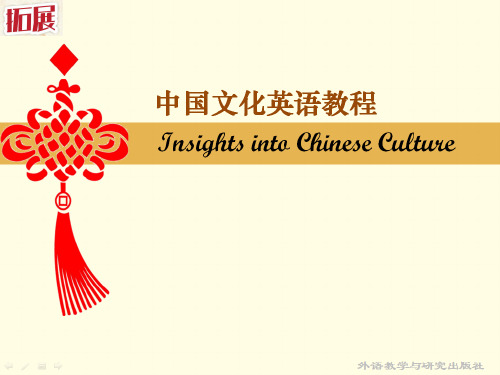
• Natural disasters on Earth were regarded as warnings to people for wrongdoings of one kind or another. And calamity (灾害) was taken as the punishment from Heaven.
• This type of architecture gives one a sense of reaching up to Heaven while ascending the steps.
Humanity and Heaven in Communion
• Ancient Chinese believed that people could communicate with Heaven, and the Temple of Heaven was built to enable this.
Ceremonial Offerings of the Emperor
• The emperor used to offer oblations (祭献) to Heaven here twice a year, in the spring and winter.
Ceremonial Offerings of the Emperor
中国墓葬文化Chinese Funeral Customs
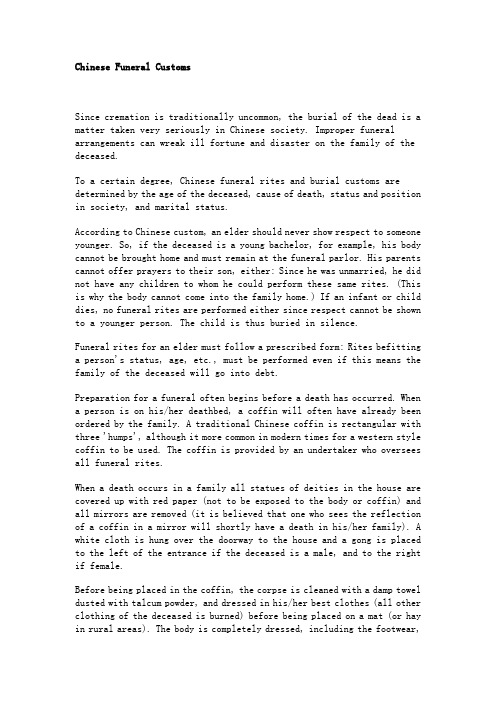
Chinese Funeral CustomsSince cremation is traditionally uncommon, the burial of the dead is a matter taken very seriously in Chinese society. Improper funeral arrangements can wreak ill fortune and disaster on the family of the deceased.To a certain degree, Chinese funeral rites and burial customs are determined by the age of the deceased, cause of death, status and position in society, and marital status.According to Chinese custom, an elder should never show respect to someone younger. So, if the deceased is a young bachelor, for example, his body cannot be brought home and must remain at the funeral parlor. His parents cannot offer prayers to their son, either: Since he was unmarried, he did not have any children to whom he could perform these same rites. (This is why the body cannot come into the family home.) If an infant or child dies, no funeral rites are performed either since respect cannot be shown to a younger person. The child is thus buried in silence.Funeral rites for an elder must follow a prescribed form: Rites befitting a person's status, age, etc., must be performed even if this means the family of the deceased will go into debt.Preparation for a funeral often begins before a death has occurred. When a person is on his/her deathbed, a coffin will often have already been ordered by the family. A traditional Chinese coffin is rectangular with three 'humps', although it more common in modern times for a western style coffin to be used. The coffin is provided by an undertaker who oversees all funeral rites.When a death occurs in a family all statues of deities in the house are covered up with red paper (not to be exposed to the body or coffin) and all mirrors are removed (it is believed that one who sees the reflection of a coffin in a mirror will shortly have a death in his/her family). A white cloth is hung over the doorway to the house and a gong is placed to the left of the entrance if the deceased is a male, and to the right if female.Before being placed in the coffin, the corpse is cleaned with a damp towel dusted with talcum powder, and dressed in his/her best clothes (all other clothing of the deceased is burned) before being placed on a mat (or hay in rural areas). The body is completely dressed, including the footwear,and cosmetics (if female), although the corpse is never dressed in red clothing (this will turn the corpse into a ghost). White, black, brown or blue are the usual colors. Before being placed in the coffin the corpse's face is covered with a yellow cloth and the body with a light blue one.The WakeThe coffin is placed on its own stand either in the house (if the person died at home) or in the courtyard (if the person died away from home). The coffin is placed with the head of the deceased facing the inside of the house, resting at about one foot from the ground on two stools; wreaths, gifts and a portrait or photograph of the deceased are placed at the head of the coffin. The coffin is not sealed during the wake. Food is placed in front of the coffin as an offering to the deceased. The deceased's comb is broken into two -- one part is placed in the coffin and the other is kept by the family.During the wake, the family does not wear jewelry or red clothing (red is the color of happiness). Traditionally, children and grandchildren of the deceased did not cut their hair for 49 days after the death, but this custom is now usually only observed by older generations. It is customary for blood relatives and daughters-in-law to wail and cry during mourning as a sign of respect and loyalty to the deceased. The cries are particularly loud if the deceased has left a large fortune.At the wake, the family members of the deceased gather around the coffin positioned according to their rank in the family and special clothing is worn: Children and daughters-in-law wear black (signifying that they grieve the most); grandchildren, blue; and great grandchildren, light blue. Sons-in-law wear brighter colors, such as white, since they are considered outsiders. The children and daughters-in-law also wear a hood of sackcloth over their heads. The eldest son sits at the left shoulder of his parent and the deceased's spouse on the right. Relatives arriving later must crawl on their knees towards the coffin.An altar where burning incense and a lit white candle are placed is positioned at the foot of the coffin. Joss paper and prayer money (to provide the deceased with sufficient income in the afterlife) are burned continuously throughout the wake. Funeral guests are required to light incense for the deceased and bow as a sign of respect to the family. There will also be a donation box since money is always offered as a sign of respect to the family of the deceased. This money will also help the family defray the costs of the funeral.During the wake there is usually a group of people gambling in the front courtyard of the deceased's house because the corpse must be "guarded," and gambling helps the guards stay awake during their vigil. This custom also helps to lessen the grief of the participants.The length of the wake depends on the financial resources of the family, although it should be at least one day long to allow for the offering of prayers. While the coffin is in the house (or compound) a monk will chant verses from Buddhist or Taoist scriptures at night. It is believed that the souls of the dead face many obstacles and even torment and torture for the sins they have committed in life before they enter the afterlife: Prayers, chanting and rituals offered by the monks help ease the passage of the deceased's soul into heaven. These prayers are accompanied by music played on the gong, flute and trumpet.Form of the Funeral CeremonyThere are two main traditions observed:1. The funeral ceremony traditionally lasts over 49 days -- the first seven being the most important. Prayers are said every seven days for 49 days if the family can afford it. Otherwise, the period can be shortened by three to seven days. Usually, it is the responsibility of the daughters to bear the funeral expenses. The head of the family should be present for at least the first and possibly the second prayer ceremony. The number of ceremonies conducted depends on the financial situation of the family. The head of the family should also be present for the burial or cremation.2. In the second tradition, the prayer ceremony is held every 10 days: The initial ceremony and three succeeding periods of 10 days until the final burial or cremation.After 100 days a final prayer ceremony is conducted, but this is optional and not as important as the initial ceremonies.In the Mahayana tradition of Buddhism, to which most Chinese Buddhists belong, it is believed that between death and rebirth there is an intermediate period called "Antarabhava" in Sanskrit or "Bardo" in Tibetan. It is an important period that influences the form that the rebirth will take. If the family ensures that proper assistance in the form of prayer and remembrance ceremonies are duly performed, the departed will be more equipped for a favorable rebirth.Funeral Ceremony and ProcessionWhen the prayer ceremonies are over, the wailing of the mourners reaches a crescendo and the coffin is nailed shut (this process represents the separation of the dead from the living). Then yellow and white "holy" paper is pasted on the coffin to protect the body from malignant spirits. During the sealing of the coffin all present must turn away since watching a coffin being sealed is considered very unlucky. The coffin is then carried away from the house using a piece of wood tied over the coffin, with the head of the deceased facing forward. It is believed that blessings from the deceased are bestowed upon the pallbearer, so there are usually many volunteers.The coffin is not carried directly to the cemetery but is first placed on the side of the road outside the house where more prayers are offered and paper is scattered. The coffin is then placed into a hearse that moves very slowly for one mile (more rarely, it is carried for a mile), with the eldest son and family members following behind with their heads touching the hearse. If there are many relatives, a white piece of cloth is used to link the hearse to family members behind. The order of the funeral procession follows the status of the family members. A white piece of cloth is tied to vehicles accompanying the hearse, or a white piece of paper can be pasted on their windshields. The eldest son usually sits next to the coffin. A long, lit joss stick is held throughout the journey, symbolizing the soul of the deceased; it is relit immediately if it goes out. Occasionally, paper models of such objects as cars, statues, ships, etc., are carried during the procession to symbolize the wealth of the deceased's family. If the procession must cross a body of water, the deceased must be informed of this since it is believed that an uninformed soul will not be able to cross water.The BurialChinese cemeteries are generally located on hillsides since this is thought to improve Fengshui (geomantic omen). The higher a grave is located, the better. At the graveside, when the coffin is taken down from the hearse and lowered into the ground, all present must turn away. Family members and other relatives throw a handful of earth into the grave before it is filled. After the funeral, all of clothes worn by the mourners are burned to avoid bad luck associated with death. After the coffin is buried, the keeper of the cemetery will also offer prayers to the deceased. Family members and relatives are presented with a red packet (a sign of gratitude from the deceased's family, and the money in it must be spent). A whitetowel is also a sign of gratitude although it is also used by funeral guests to wipe away perspiration.The eldest son of the deceased will retrieve some earth from the grave to put into an incense holder, and the deceased will be worshipped by the family at home using an ancestral tablet.MourningAlthough the funeral rites are over, the period of mourning by the family continues for another 100 days. A piece of colored cloth is worn on the sleeve of each of the family members for 100 days to signify mourning: Black is worn by the deceased's children, blue by the grandchildren and green by the great grandchildren. More traditional families will wear the pieces if cloth for up to three years. A period of mourning is not required if the deceased is a child or a wife.The Return of the DeadThe Chinese believe that seven days after the death of a family member the soul of the departed will return to his/her home. A red plaque with a suitable inscription may be placed outside the house at this time to ensure that the soul does not get lost.On the day of the return of the soul, family members are expected to remain in their rooms. Flour or talcum powder may be dusted on the floor of the entrance hall of the home to detect the visit.。
Chinese Imperial Tombs学生版
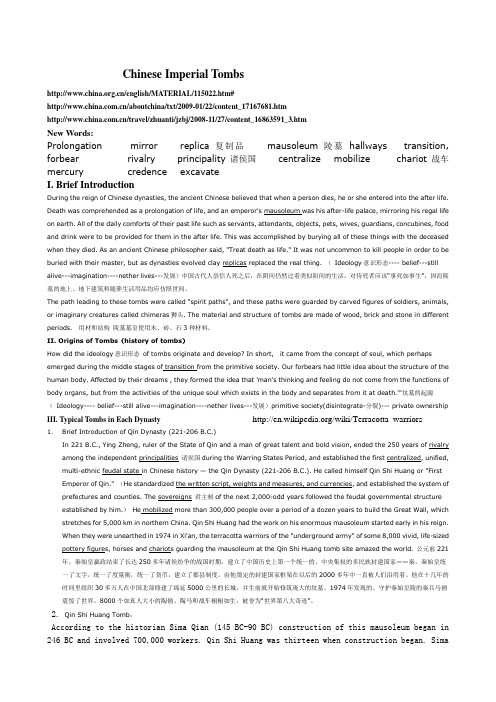
Chinese Imperial Tombs/english/MATERIAL/115022.htm#/aboutchina/txt/2009-01/22/content_17167681.htm/travel/zhuanti/jzbj/2008-11/27/content_16863591_3.htmNew Words:Prolongation mirror replica复制品mausoleum陵墓hallways transition, forbear rivalry principality 诸侯国centralize mobilize chariot战车mercury credence excavateI. Brief IntroductionDuring the reign of Chinese dynasties, the ancient Chinese believed that when a person dies, he or she entered into the after life. Death was comprehended as a prolongation of life, and an emperor's mausoleum was his after-life palace, mirroring his regal life on earth. All of the daily comforts of their past life such as servants, attendants, objects, pets, wives, guardians, concubines, food and drink were to be provided for them in the after life. This was accomplished by burying all of these things with the deceased when they died. As an ancient Chinese philosopher said, "Treat death as life." It was not uncommon to kill people in order to be buried with their master, but as dynasties evolved clay replicas replaced the real thing. (Ideology意识形态---- belief---still alive---imagination----nether lives---发展)中国古代人崇信人死之后,在阴间仍然过着类似阳间的生活,对待死者应该“事死如事生”,因而陵墓的地上、地下建筑和随葬生活用品均应仿照世间。
关于中国陵墓的英文书
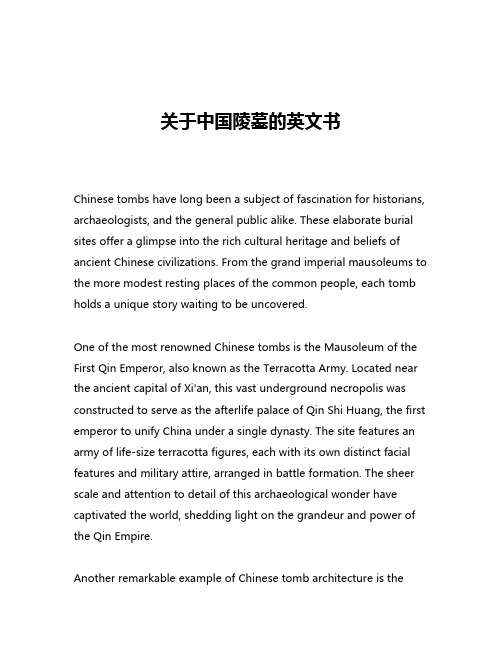
关于中国陵墓的英文书Chinese tombs have long been a subject of fascination for historians, archaeologists, and the general public alike. These elaborate burial sites offer a glimpse into the rich cultural heritage and beliefs of ancient Chinese civilizations. From the grand imperial mausoleums to the more modest resting places of the common people, each tomb holds a unique story waiting to be uncovered.One of the most renowned Chinese tombs is the Mausoleum of the First Qin Emperor, also known as the Terracotta Army. Located near the ancient capital of Xi'an, this vast underground necropolis was constructed to serve as the afterlife palace of Qin Shi Huang, the first emperor to unify China under a single dynasty. The site features an army of life-size terracotta figures, each with its own distinct facial features and military attire, arranged in battle formation. The sheer scale and attention to detail of this archaeological wonder have captivated the world, shedding light on the grandeur and power of the Qin Empire.Another remarkable example of Chinese tomb architecture is theTomb of the Yellow Emperor, believed to be the resting place of the legendary ruler Huangdi, considered the ancestor of the Chinese people. Located in Shaanxi province, the tomb is a massive, stepped pyramid-like structure surrounded by a complex of smaller tombs, temples, and other architectural features. The site is not only significant for its historical and cultural value but also serves as a important pilgrimage destination for those seeking to connect with their ancestral roots.Moving beyond the imperial tombs, the burial practices of the common people in ancient China also offer fascinating insights. In the Sichuan province, the Jinsha Site has revealed a wealth of well-preserved tombs from the Shu Kingdom, dating back to the 3rd century BCE. These tombs, often adorned with intricate jade carvings, bronze artifacts, and other funerary goods, provide a glimpse into the beliefs, social structures, and everyday lives of the Shu people.The Chu Tombs, found in the Hubei province, are another remarkable example of non-royal Chinese tomb architecture. These elaborate underground structures, some spanning multiple levels, were built to accommodate the elaborate burial rituals and beliefs of the Chu culture. Excavations have unearthed an array of artifacts, including lacquerware, musical instruments, and even preserved textiles, offering a unique perspective on the material culture and artistic traditions of this ancient civilization.Beyond the physical structures, the burial rituals and beliefs associated with Chinese tombs are equally captivating. The concept of filial piety, a cornerstone of Confucian philosophy, played a significant role in shaping funeral practices and the design of tombs. The deceased were often buried with personal belongings, food, and other items deemed necessary for the afterlife, reflecting the deep-rooted belief in the continuity of life after death.The use of feng shui, the ancient Chinese art of spatial arrangement and harmonization, was also integral to the placement and orientation of tombs. Careful consideration was given to the surrounding landscape, the position of celestial bodies, and the flow of natural energies to ensure the deceased's peaceful and prosperous transition to the afterlife.The tomb of the Marquis of Dai, discovered in the Hunan province, provides a remarkable example of the integration of these spiritual beliefs and practices. The tomb, dating back to the 2nd century BCE, features an intricate system of passageways, chambers, and burial goods that reflect the complex cosmological and ritual understanding of the Chu culture.In recent years, the preservation and study of Chinese tombs have become increasingly important, as they offer invaluable insights intothe country's rich history and cultural heritage. Efforts are being made to protect these sites from the ravages of time and human interference, ensuring that future generations can continue to unravel the mysteries and stories they hold.As we delve deeper into the world of Chinese tombs, we are reminded of the enduring human desire to honor the dead, preserve cultural traditions, and connect with the past. These remarkable burial sites stand as a testament to the ingenuity, beliefs, and aspirations of ancient Chinese civilizations, inviting us to explore and appreciate the remarkable diversity and depth of this extraordinary cultural legacy.。
中国文物古董墓葬的英文介绍_
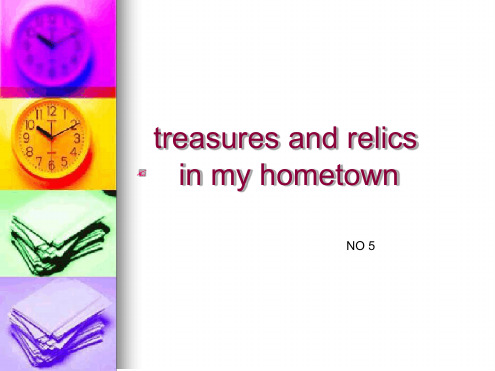
thank you
treasures and relics ? in my hometown
NO 5
My hometown is in Zhangjiachuan County of Gansu Province , its a small county in the northwest of china. on july 19th,2006, in my hometown, 3 strangers in taoyuan village attracted the police's attention, and they were eventually identified as the ghouls(盗墓 者).the police found some Precious relics in
? Over thousand artifacts from the Taoyuan village were found, most of them were handed to the Gansu Provincial Museum
? The remaining artifacts, including a variety of different Gold, silver, copper, iron, bone, pottery and thousands of Turquoise(绿松 石), agate (玛瑙)and coloured glaze(琉璃)
these artifacts showed the daily life and the Sacrificial rites of people from the Warring States period (战国时期)
中国葬礼文化 英语短文
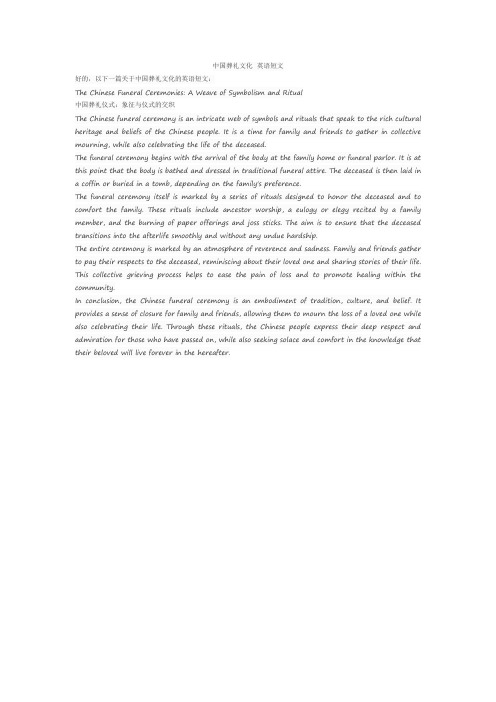
中国葬礼文化英语短文好的,以下一篇关于中国葬礼文化的英语短文:The Chinese Funeral Ceremonies: A Weave of Symbolism and Ritual中国葬礼仪式:象征与仪式的交织The Chinese funeral ceremony is an intricate web of symbols and rituals that speak to the rich cultural heritage and beliefs of the Chinese people. It is a time for family and friends to gather in collective mourning, while also celebrating the life of the deceased.The funeral ceremony begins with the arrival of the body at the family home or funeral parlor. It is at this point that the body is bathed and dressed in traditional funeral attire. The deceased is then laid in a coffin or buried in a tomb, depending on the family's preference.The funeral ceremony itself is marked by a series of rituals designed to honor the deceased and to comfort the family. These rituals include ancestor worship, a eulogy or elegy recited by a family member, and the burning of paper offerings and joss sticks. The aim is to ensure that the deceased transitions into the afterlife smoothly and without any undue hardship.The entire ceremony is marked by an atmosphere of reverence and sadness. Family and friends gather to pay their respects to the deceased, reminiscing about their loved one and sharing stories of their life. This collective grieving process helps to ease the pain of loss and to promote healing within the community.In conclusion, the Chinese funeral ceremony is an embodiment of tradition, culture, and belief. It provides a sense of closure for family and friends, allowing them to mourn the loss of a loved one while also celebrating their life. Through these rituals, the Chinese people express their deep respect and admiration for those who have passed on, while also seeking solace and comfort in the knowledge that their beloved will live forever in the hereafter.。
中国传统葬礼的英文介绍
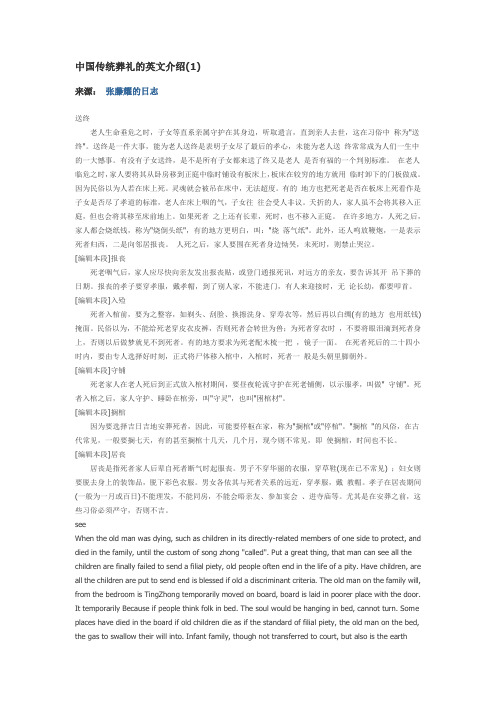
中国传统葬礼的英文介绍(1)来源:张藤耀的日志送终老人生命垂危之时,子女等直系亲属守护在其身边,听取遗言,直到亲人去世,这在习俗中称为"送终"。
送终是一件大事,能为老人送终是表明子女尽了最后的孝心,未能为老人送终常常成为人们一生中的一大憾事。
有没有子女送终,是不是所有子女都来送了终又是老人是否有福的一个判别标准。
在老人临危之时,家人要将其从卧房移到正庭中临时铺设有板床上,板床在较穷的地方就用临时卸下的门板做成。
因为民俗以为人若在床上死。
灵魂就会被吊在床中,无法超度。
有的地方也把死老是否在板床上死看作是子女是否尽了孝道的标准,老人在床上咽的气,子女往往会受人非议。
夭折的人,家人虽不会将其移入正庭,但也会将其移至床前地上。
如果死者之上还有长辈,死时,也不移入正庭。
在许多地方,人死之后,家人都会烧纸钱,称为"烧倒头纸",有的地方更明白,叫:"烧落气纸"。
此外,还人鸣放鞭炮,一是表示死者归西,二是向邻居报丧。
人死之后,家人要围在死者身边恸哭,未死时,则禁止哭泣。
[编辑本段]报丧死老咽气后,家人应尽快向亲友发出报丧贴,或登门通报死讯,对远方的亲友,要告诉其开吊下葬的日期。
报丧的孝子要穿孝服,戴孝帽,到了别人家,不能进门,有人来迎接时,无论长幼,都要叩首。
[编辑本段]入殓死者入棺前,要为之整容,如剃头、刮脸、换擦洗身、穿寿衣等,然后再以白绸(有的地方也用纸钱)掩面。
民俗以为,不能给死老穿皮衣皮裤,否则死者会转世为兽;为死者穿衣时,不要将眼泪滴到死者身上,否则以后做梦就见不到死者。
有的地方要求为死老配木梳一把,镜子一面。
在死者死后的二十四小时内,要由专人选择好时刻,正式将尸体移入棺中,入棺时,死者一般是头朝里脚朝外。
[编辑本段]守铺死老家人在老人死后到正式放入棺材期间,要昼夜轮流守护在死老铺侧,以示服孝,叫做" 守铺"。
死者入棺之后,家人守护、睡卧在棺旁,叫"守灵",也叫"困棺材"。
- 1、下载文档前请自行甄别文档内容的完整性,平台不提供额外的编辑、内容补充、找答案等附加服务。
- 2、"仅部分预览"的文档,不可在线预览部分如存在完整性等问题,可反馈申请退款(可完整预览的文档不适用该条件!)。
- 3、如文档侵犯您的权益,请联系客服反馈,我们会尽快为您处理(人工客服工作时间:9:00-18:30)。
A. The Grave-robbery is a social and cultural phenomenon since ancient times.
(盗墓,是渊源古远的社会文化现象。可以说,自从有了墓葬文化, 就有了盗墓行业的存在。)
B. Species: The official or
folk
竖穴墓:一般为长方形或方形土穴作墓,商朝时出现亚字
型与中字型竖穴墓(天子之制),还有形制低于“亚”,“中” 的甲字型墓,凸字型墓等。 横穴墓(砖室墓)
方形竖穴墓
•亚字形墓的墓室,是一个巨大的方形或亚字形的竖穴式土 坑,四面各有一个墓道。商王和各级贵族的墓,都用木材筑 成椁室。 • 中字形墓的墓室,是一个大型的长方形竖穴式土坑,南北 两面各有一个墓道。(如:武官村墓葬)
– 竖穴木椁墓(黄肠题凑)
Luxury at han – 在西汉前期,黄肠题凑和玉衣、梓宫、便房、外 藏椁同为帝王规格陵墓的组成部分(天子之制), 是汉代厚葬之风的产物,在汉代以后很少使用
– 砖室墓(以横穴式的洞穴作墓圹,用砖和石料筑墓室, 在形制上模仿现实生活中的房屋。这是中国古代墓制 的一次划时代的大变化)
•塔葬是中国藏族的葬仪风俗之一,是藏族中最为高贵、最高待遇与最高规格的一种葬式, 其又称灵塔葬。
A. Appeared in the Spring and Autumn
Period around.
(出现于春秋前后,东周以前的墓葬是没有封土的。)
B. For the Emperor.
(对于普通老百姓而言,这个土丘就叫做坟头。对于帝王,由于这个土 丘往往很大,而且很气派,为表示出帝王的身份,专称为封土。)
明器(冥器)
• 指的是专门为随葬而制作的器物,仿实物制作的, 不能实用。 • 一般用陶瓷木石制作,也有金属或纸制的。 • 俑(象征殉葬奴隶的模拟品)
1.祭祀建筑区:主要建筑物是祭殿 2.神道 3.护陵监:护陵监是专门保护和管理陵园的机构,防止被盗掘 和破坏。
事大者《 死象,荀 如其以子 生生生 ,,者礼 事以饰论 亡送死》 如其者: 存死也丧 。,,礼 .
和竹简、漆器、玉石器等。
凿山为墓 漆棺和镶玉漆棺 玉衣 随葬器物4200余件,包括陶器、铜器、铁器、
金银器、玉石器、漆器、纺织品、车马、俑、 钱币等。
长沙马王堆汉墓
一号墓主人,辛追,素有“东方睡美人”之称。
A. QinShiHuang Mausoleum
B. Qian Mausoleum
+ 悬Βιβλιοθήκη 葬,以将死者的棺木放置在人迹罕至的悬崖绝壁之上为特征
•Tower burial is one of the funeral burial customs of Chinese Tibetan. It is the most noble, the highest treatment with the highest standard of a funeral ceremony.
半地穴式房屋 Semi subterranean houses
墓葬特点 The burial characteristics
•裴李岗文化,大汶口文化和龙山文化也有墓葬出现
人面鱼纹盆
Public cemetery joint burials
,
埋葬未成年人用的瓮罐 Burial urn pot with minors
甬道
斜坡式的墓道,包括一段很长的隧道;隧道顶部开天井,两 壁设龛。
2. 大多数都是“依山为陵” 3.
玄宫分前、中、后3室
仿木结构砖室墓,此后墓室的平面又从方形或圆形 演变为等边多角形。
2.
一般多为单室墓,后期较大的墓则分前后两室。
3. Ear chamber
多设耳室。
Mausoleum of the Ming Dynasty
+ Ten ways to anti theft古代墓葬防盗十术:
• • • • • • • • • • 01、弓弩箭术 。(bow and arrow) 02、流沙术。(quicksand) 03、连环翻板术。(chain flap) 04、铁索吊石术。( Cable hanging stone) 05、施毒术。( poison)(eg:秦始皇陵的水银毒气) 06、水火相攻术。(Water and fire attack) 07、迷宫术。 ( maze) 08、密葬术。 ( Secret burial) 09、坚固术。 (Solid burial) 10、诅咒术。 (curse at fate)
明代的帝陵
与汉唐以来的帝陵相比,明陵最大的特点是坟丘不成方形 而成圆形,周围砌砖墙,称为宝城,其位置不在陵域的中 部而居全陵的最后。宝城之前设明楼,楼上树石碑,上刻 皇帝的谥号,这也是明陵的新创。玄宫在宝城之下,其形 制亦系模仿宫殿。以已经发掘的明定陵为例,玄宫可分前 殿、中殿和后殿,中殿的左右两侧又各通一配殿。皇帝和 皇后的棺椁放置在后殿的棺床上。
(Eg:摸金校尉起源于东汉末年三国时期,当时魏军的领袖曹操为了弥补军饷的不足, 设立发丘中郎将,摸金校尉等军衔,专司盗墓取财,贴补军用)
C. Purpose: a) For money b) For revenge c) Superstition and witchcraft(迷信巫术) d) For entertainment
+ After Ming dynasty, no changes
– 朱元璋修改简化陵寝制度,从此中国的陵寝制度不再变迁
+ The Qing Dynasty basically followed the Ming
Dynasty, but the Sacrifice is complex than before.
+ 墓葬风水是一门科学,一个显著的特性就是强调
人与自然环境生气的和谐。墓地风水也是一门和 平相处的艺术,选择墓地时候可考虑
+ 阴宅风水是古代王公贵族在墓地选址时必不可少
的一部分,当然也为盗墓者“寻龙点穴”提供了 良好的教育示范作用。。。
《葬书》曰:“夫阴阳之气噫为风,升为云,斗为雷,降为雨,行平地中而为生气”
中国古代墓葬
Ancient Chinese tombs
+ 树葬分为古代树葬和
现代树葬。古代树葬 在中国东北和西南的 少数民族地区颇为常 见。
+ 崖墓葬,是在崖穴洞窟中安葬人
的遗体的一种葬俗,一般选择在江 河沿岸山腰或山足下的断崖上,依石 向内造出墓道和墓室。崖葬习俗早 在中国古代濮、 越、 巴、僚、汉等 民族特有的一种丧葬形式,也是我 国多种葬法中最古老、最特别的一 种丧葬形式。
1. To protect the body(保护尸体):各种防腐
用具,玉衣,玉塞
2. Necessities and luxuries(生活用品及奢侈
品):家具,衣物,货币,书画玩器,金银玉器等
3. A status symbol
章,仪仗,法器,壁画等
(身份地位的象征):礼器,印
4. Burial objects
中国古代人崇信人死之后,在阴间仍然过着类似阳间的生活,对待死者应该“事死 如事生”,因而陵墓的地上、地下建筑和随葬生活用品均应仿照世间。 是 文献记载,秦汉时代陵区内设殿堂收藏已故帝王的衣冠、用具,置宫人献食,犹如 生时状况。秦始皇陵地下寝宫内“上具天文,下具地理”,“以水银为百川江河大 海”,并用金银珍宝雕刻鸟兽树木,完全是人间世界的写照。
今京 石 约山 器 顶 时 洞 期 年人 前遗 址
18000
Paleolithic period
新石器时期 The Neolithic period
•半坡遗址 (仰韶文化) The banpo matriarchs ( Yangshao culture)
距今6000年左右
母系氏族 The matriarchal clan
乾陵
秦始皇陵
(唐高宗李治与武则天的合葬墓)
– 唐十八陵中唯一没有被盗的陵墓,也是唯一一座女皇陵。 – 依山为陵
Here I ask you a question, whether it is the tomb of + 黄帝为传说中人物,此陵墓为衣冠冢,是后人所建。 ancient China's first emperor mausoleum?
Chinese people first burial, the earliest funeral ceremony 中国人最早的墓葬,最早的丧葬仪式 距北 旧
– 清朝基本沿袭明朝,但祭祀活动比之前繁杂
“享堂”
甲骨 文 青铜 文化 祭祀 文化
• 一片甲骨惊天下
• 司母戊鼎 • 三联甗偶方彝
• 葬仪 • 殉葬
+ 多边形岩坑竖穴墓,深13米。椁室周围及顶填充6
万公斤木炭,之上有10-30公分青膏泥,其上为夯土, 再上铺石板,石板之上为封土。
+ 彩绘漆棺。 + 殉人13具。 + 随葬器物15000余件。包括青铜礼器、乐器、兵器
